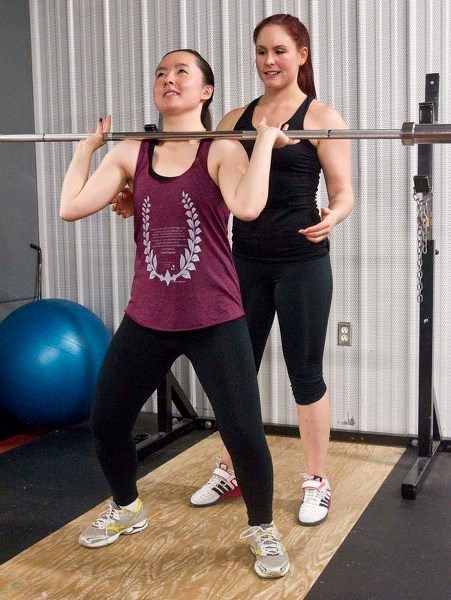My flushed face grimaces underneath the weight of the bar. My trapezius muscles feel as if they’ve been turned to stone. Beside me I hear a grunt of physical exertion then SLAM! as a weight-laden barbell hits and bounces off the floor.
I’m at St. Albert’s Servus Credit Union Place where exercise and wellness specialist Megan Lauer is showing me the world of Olympic weightlifting.
Most are familiar with the sport as part of the Olympic program. The athletic discipline involves a maximum-weight single lift of a barbell loaded with weight plates. But many athletes use Olympic weightlifting to develop the strength and explosiveness required in other sports such as hockey, football, wrestling and sprinting.
“I got into it because I’m a female strength and conditioning coach in a male-dominated industry. I felt like I needed to up my game by knowing how to train my clients and train my athletes,” said Lauer, noting that athletes in the big leagues – the Edmonton Oilers and Edmonton Eskimos – cross-train with weights and the idea is becoming more mainstream.
Lauer explained that cross-fitters – members of the strength and conditioning program that use a combination of aerobic exercises, body weight exercises and weightlifting to improve muscle strength and cardio-respiratory endurance – are among her clients. Others just want to add something different to their regular exercise routine or perfect their technique.
In Olympic weightlifting, lifts are classified into the snatch and the clean and jerk as well as variations such as the power snatch, power jerk, hang snatch and hang clean.
Under Lauer’s supervision I tried the power clean.
The most basic of lifts, the power clean involves pulling the barbell from the floor to the knees, then from mid-thighs up to the shoulders where it rests on the clavicles.
The second pull of the movement is the trickiest, I learned, as the focus is on moving the barbell in a straight line close to your body while extending through your knees, hips and ankles.
“As you jump, the power from your legs and the triple extension is going to help the bar come up,” said Lauer.
Since this was my first taste of Olympic weightlifting, I stuck to the 15-kilogram bar, the standard for women. I soon realized the weight of the bar wasn’t the issue, it was mastering the technique.
“It takes time, it’s not as easy as hopping on a spin bike,” assured Lauer, adding the power clean might take as much as three sessions to master.
The power clean builds both power (speed) and muscle development, especially in the calves, hamstrings, glutes, lower and upper back, shoulders and core. My traps definitely bore the brunt of it.
I left my one-hour session intrigued by the athletic discipline of Olympic weightlifting. I admit, initially I was a bit intimidated, not necessarily by the weight, but of the stigma of weightlifting – body building and bulk.
However, I left feeling empowered, that I tried something outside of my comfort zone.
“Strong is the new skinny,” said Lauer. “There’s a small number of women in this sport (but) it’s growing because women aren’t afraid to try different things and aren’t afraid to lift weights.”
Gazette reporter Amy Crofts will try a different workout each month in an attempt to inspire people to start their fitness New Year’s resolutions early, rather than just in January. If you have a workout idea, e-mail: [email protected].




